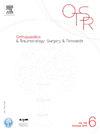Osteotomies for genu varum: Should we always correct at the tibia? A multicenter analysis of practices in France
IF 2.3
3区 医学
Q2 ORTHOPEDICS
引用次数: 0
Abstract
Introduction
Tibial correction is often performed during a valgus-producing osteotomy for genu varum. However, overcorrection and the creation of a joint line obliquity (JLO) have been associated with unfavorable functional outcomes after high tibial osteotomy (HTO). The aims of this study were to analyze: 1) the corrections obtained after HTO; 2) the rationale behind the indication per the European Society for Sports Traumatology Surgery and Arthroscopy (ESSKA) recommendations; and 3) the correlation between the postoperative corrections obtained and functional outcomes.
Hypothesis
A significant number of patients who underwent an isolated HTO did not present an “ideal” theoretical indication based on the preoperative angles and correction targets to be performed.
Materials and methods
This multicenter study included 289 isolated HTOs. Demographic and morphometric data were anonymized and compiled in a database. Preoperative radiographic parameters were compared with the ESSKA consensus recommendations on osteotomies for genu varum. The consensus defined the “ideal” indication for performing an HTO as medial tibiofemoral compartment pain with significant tibial varus deformity (medial proximal tibial angle [MPTA] < 85 °), no significant femoral varus deformity (lateral distal femoral angle [LDFA] < 90 °), an expected postoperative obliquity of less than 5 °, and a correction resulting in moderate tibial valgus (postoperative MPTA < 94 °). The incidence of patients with an “ideal” theoretical indication for isolated HTO and those with a theoretical indication not perfectly justified by the radiographic data and preoperative planning were recorded.
Results
Under the ESSKA consensus criteria, 25.3% (n = 73) of isolated HTOs, 15.6% (n = 45) of isolated femoral osteotomies, 9.3% (n = 27) of double-level osteotomies, and 49.9% (n = 144) of cases where no osteotomy was performed due to the lack of significant extra-articular tibial and/or femoral deformity were deemed justified. The presence of a preoperative femoral deformity and the absence of an “ideal” indication for HTO did not affect the postoperative Tegner Activity Scale or the Western Ontario and McMaster Universities Osteoarthritis Index (WOMAC) scores (p > 0.05). A high preoperative hip-knee-ankle (HKA) angle and MPTA, which indicated less varus, were associated with a greater risk of there being no “ideal” theoretical indication for an HTO (coefficient of determination [R2] = 0.19 and R2 = 1, respectively; p < 0.001).
Conclusion
This study showed that isolated HTOs in current practice were not justified in a significant number of patients, even though they could lead to tibial overcorrection and excessive JLO. This did not impact the functional results of this series, but it might complicate the performance of a secondary knee arthroplasty. Nevertheless, some young patients in this series underwent a salvage osteotomy outside the “ideal” indications of the European recommendations.
Level of evidence
IV; case series.
真性下垂的截骨术:我们是否应该总是在胫骨处进行矫正?法国多中心实践分析。
简介胫骨矫正通常是在针对膝外翻的外翻截骨术中进行的。然而,过度矫正和关节线偏斜(JLO)与高胫骨截骨术(HTO)后的不良功能结果有关。本研究旨在分析:1)胫骨高位截骨术后的矫正情况;2)根据欧洲运动创伤外科和关节镜学会(ESSKA)的建议进行矫正的理由;3)术后矫正与功能预后之间的相关性:材料与方法:这项多中心研究纳入了 289 例接受孤立 HTO 的患者:这项多中心研究包括 289 例孤立 HTO。人口统计学和形态计量学数据已匿名化并编入数据库。将术前放射学参数与ESSKA关于真性下垂截骨术的共识建议进行比较。该共识将 HTO 的 "理想 "适应症定义为:胫骨股骨内侧室疼痛,伴有明显的胫骨外翻畸形(胫骨近端内侧角 [MPTA] < 85°),无明显的股骨外翻畸形(股骨远端外侧角 [LDFA] < 90°),术后斜度预计小于 5°,矫正后胫骨中度外翻(术后 MPTA < 94°)。我们记录了具有孤立 HTO "理想 "理论指征的患者的发生率,以及那些在影像学数据和术前规划中理论指征并不完全合理的患者的发生率:根据ESSKA共识标准,25.3%(n = 73)的孤立HTO、15.6%(n = 45)的孤立股骨截骨、9.3%(n = 27)的双水平截骨以及49.9%(n = 144)的因缺乏明显的关节外胫骨和/或股骨畸形而未进行截骨的病例被认为是合理的。术前股骨畸形的存在和HTO "理想 "指征的缺乏并不影响术后Tegner活动量表或西安大略和麦克马斯特大学骨关节炎指数(WOMAC)的评分(P > 0.05)。术前髋-膝-踝(HKA)夹角和MPTA较高,表明曲度较小,与没有HTO "理想 "理论指征的风险较大相关(决定系数[R2]分别为0.19和R2=1;P < 0.001):这项研究表明,在目前的临床实践中,孤立的HTO在相当多的患者中是不合理的,尽管HTO可能导致胫骨过度矫正和过度的JLO。这并不影响该系列手术的功能结果,但可能会使二次膝关节置换术的实施复杂化。尽管如此,该系列中仍有一些年轻患者在欧洲建议的 "理想 "适应症之外接受了挽救性截骨手术:证据级别:IV;病例系列
本文章由计算机程序翻译,如有差异,请以英文原文为准。
求助全文
约1分钟内获得全文
求助全文
来源期刊
CiteScore
5.10
自引率
26.10%
发文量
329
审稿时长
12.5 weeks
期刊介绍:
Orthopaedics & Traumatology: Surgery & Research (OTSR) publishes original scientific work in English related to all domains of orthopaedics. Original articles, Reviews, Technical notes and Concise follow-up of a former OTSR study are published in English in electronic form only and indexed in the main international databases.

 求助内容:
求助内容: 应助结果提醒方式:
应助结果提醒方式:


